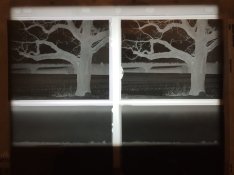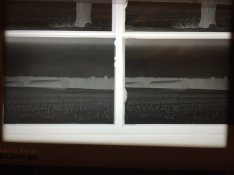- Home
- Forums
- Analog Workflow Forums (100% Analog/Traditional)
- Analog Equipment
- 35mm Cameras and Accessories
You are using an out of date browser. It may not display this or other websites correctly.
You should upgrade or use an alternative browser.
You should upgrade or use an alternative browser.
Filtering for Acros 100/
-
A
- Thread starter chip j
- Start date
Recent Classifieds
-
Sold Ilford HP5 Plus 400 4x5 Film
- Started by Barlow
-
For Sale 4 Toyo 4x5 Film Holders
- Started by Barlow
-
Want to Buy Mounting Flange for Compur 2 Dial Set Shutter
- Started by ivan35mm
-
Sold SOLD!
- Started by B.S.Kumar
-
For Sale FS: Sekonic L-758DR DigitalMaster light Meter
- Started by pascalkea
Forum statistics
fretlessdavis
Member
To me, it seems slightly more Ortho than Delta or Tmax 100. It doesn't respond to a red filter very well-- skys don't get much darker, and green foliage just goes to pure black.... even going to a stop more than recommended filter factor. Other than that, for me at least, filters behave like they would on Delta or Tmax. If I want really dramatic skys, I'll stack a polarizer and a yellow or orange.
kazuo
Member
Is panchromatic, at least this is what the spectral curve says http://www.fujifilmusa.com/shared/bin/NeopanAcros100.pdf
Here is the one for TMAX 100 http://www.kodak.com/global/en/professional/support/techPubs/f4016/f4016.pdf
Here is the one for TMAX 100 http://www.kodak.com/global/en/professional/support/techPubs/f4016/f4016.pdf
lxdude
Member
Note that on that data sheet they call it orthopanchromatic.Is panchromatic, at least this is what the spectral curve says http://www.fujifilmusa.com/shared/bin/NeopanAcros100.pdf
Neal
Subscriber
Dear Chip j,
Those two claims are contradictory. Generally, "ortho" films are only sensitive to blue and some green. Extended red sensitivity means that the film would record at least partially into the infra-red. That would be quite a problem for ortho films, particularly when you go to develop by inspection. What I think folks are getting at is that traditional films were, relatively, less sensitive to blue than red and therefore using a red filter would give you darker skies compared to the newest films (Acros/Delta/T-Max) which have a much flatter spectral sensitivity.
What I think folks are getting at is that traditional films were, relatively, less sensitive to blue than red and therefore using a red filter would give you darker skies compared to the newest films (Acros/Delta/T-Max) which have a much flatter spectral sensitivity.
Go with FP-4+ if you want that old sky look with finer grain.
I think I added enough qualifiers in the above to wiggle out of trouble. Good luck,
Good luck,
Neal Wydra
Those two claims are contradictory. Generally, "ortho" films are only sensitive to blue and some green. Extended red sensitivity means that the film would record at least partially into the infra-red. That would be quite a problem for ortho films, particularly when you go to develop by inspection.
 What I think folks are getting at is that traditional films were, relatively, less sensitive to blue than red and therefore using a red filter would give you darker skies compared to the newest films (Acros/Delta/T-Max) which have a much flatter spectral sensitivity.
What I think folks are getting at is that traditional films were, relatively, less sensitive to blue than red and therefore using a red filter would give you darker skies compared to the newest films (Acros/Delta/T-Max) which have a much flatter spectral sensitivity.Go with FP-4+ if you want that old sky look with finer grain.
I think I added enough qualifiers in the above to wiggle out of trouble.
 Good luck,
Good luck,Neal Wydra
pentaxuser
Member
Dear Chip j,
What I think folks are getting at is that traditional films were, relatively, less sensitive to blue than red and therefore using a red filter would give you darker skies compared to the newest films (Acros/Delta/T-Max) which have a much flatter spectral sensitivity.
Go with FP-4+ if you want that old sky look with finer grain.
I think I added enough qualifiers in the above to wiggle out of trouble.Good luck,
Neal Wydra
Neal, I think you are saying that the trad grain films such as FP4 will give darker skies with a red filter and yet in the case of TMax Kodak states that it is less sensitive to blue giving darker blues( closer to how the eyes sees blue) so I'd presume that with a red the TMax skies should be darker
In the Kodak quote however I don't think it says what it is less sensitive than. Is it FP4+, HP5+, Tri-X? It just doesn't say unfortunately
pentaxuser
StoneNYC
Member
Neal, I think you are saying that the trad grain films such as FP4 will give darker skies with a red filter and yet in the case of TMax Kodak states that it is less sensitive to blue giving darker blues( closer to how the eyes sees blue) so I'd presume that with a red the TMax skies should be darker
In the Kodak quote however I don't think it says what it is less sensitive than. Is it FP4+, HP5+, Tri-X? It just doesn't say unfortunately
pentaxuser
FWIW I just did a comparison with a red filter of TMY-2 and FP4+ and the negs and (scanned) images look almost identical...
Here are the results. Sorry not printed optically
 but thought it might be helpful to post none the less...
but thought it might be helpful to post none the less...FP4+

TMY-2

Both with red filter, both in DD-X both with exact same exposure (2 stop difference obviously).
Neal
Subscriber
Hi Pentaxuser,
If a film is less sensitive to blue than red, the unfilltered sky will be slightly less dense and appear slightly darker when printed.
At least I think that's right.
Neal Wydra
If a film is less sensitive to blue than red, the unfilltered sky will be slightly less dense and appear slightly darker when printed.
At least I think that's right.
Neal Wydra
Neal
Subscriber
Dear StoneNY,
I believe you have clearly demonstrated that the vast majority the differences discussed is, for all practical purposes, picking the fly poop out of the pepper.
Neal Wydra
I believe you have clearly demonstrated that the vast majority the differences discussed is, for all practical purposes, picking the fly poop out of the pepper.
Neal Wydra
Fixcinater
Member
FWIW I just did a comparison with a red filter of TMY-2 and FP4+ and the negs and (scanned) images look almost identical...
Here are the results. Sorry not printed opticallybut thought it might be helpful to post none the less...
FP4+
View attachment 83916
TMY-2
View attachment 83917
Both with red filter, both in DD-X both with exact same exposure (2 stop difference obviously).
Thanks for posting this.
Just to satisfy curiosity, did you set contrast (or: black and white points) equal to each other or to taste individually? The only "real" difference I see is the TMY-2 frame going a bit darker in the deep shadows, hence my question.
Thanks again for the comparison.
StoneNYC
Member
Thanks for posting this.
Just to satisfy curiosity, did you set contrast (or: black and white points) equal to each other or to taste individually? The only "real" difference I see is the TMY-2 frame going a bit darker in the deep shadows, hence my question.
Thanks again for the comparison.
I essentially let the scanner do it's thing, but from my experience, in a given scene that is comparable, the scanner will give the proper comparison... This MIGHT help....
Yellow filter

Red filter

To qualify, the clouds did change the exposure slightly and you can see the sky is more exposed in one as the sun "burst through" just as I was shooting, but relatively speaking I think this will be helpful to see as a reference, also obviously there's no accounting for differences in development times where I might have over developed, etc, still getting used to the rotary processor times.
| Photrio.com contains affiliate links to products. We may receive a commission for purchases made through these links. To read our full affiliate disclosure statement please click Here. |
PHOTRIO PARTNERS EQUALLY FUNDING OUR COMMUNITY:  |









